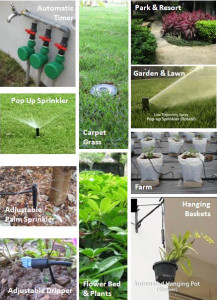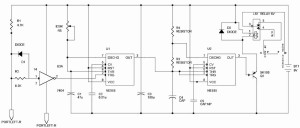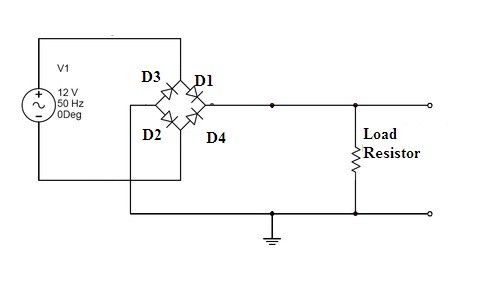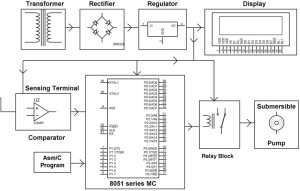
Automatic Plant Irrigation System
In present days, in the field of agriculture farmers are facing major problems in watering their crops. It’s because they don’t have proper idea about the availability of the power. Even if it is available, they need to pump water and wait until the field is properly watered, which compels them to stop doing other activities – which are also important for them, and thus they loss their precious time and efforts. But, there is a solution – an automatic plant irrigation system not only helps farmers but also others for watering their gardens as well.
This automatic irrigation system senses the moisture content of the soil and automatically switches the pump when the power is on. A proper usage of irrigation system is very important because the main reason is the shortage of land reserved water due to lack of rain, unplanned use of water as a result large amounts of water goes waste. For this reason, we use this automatic plant watering system, and this system is very useful in all climatic conditions.
Automatic Plant Irrigation System
The power supply consists of a step-down transformer, which steps down the voltage to 12VAC. By using a bridge rectifier this AC is converted to DC, then it is regulated to 5v using a voltage regulator which is used for the operation of the microcontroller.

Block Diagram of Automatic Plant Irrigation System
The block diagram of this automatic plant irrigation system comprises three main components namely a microcontroller, a motor-driver circuit and a sensor circuit. When the sensor circuit senses the condition of soil, it compares it with the reference voltage 5v. This process is done by a 555 timer.
When the soil condition is less than the reference voltage, i.e., 5v, then the soil is considered as dry and instantly the 555 timer sends the logic signal 1 to the microcontroller. The microcontroller then turns on the motor driver circuit and prompts the motor to pump water to the plants. When the soil condition is greater than the reference voltage, the soil becomes dry. Then the timer sends the logic signal 0 to the microcontroller, this turns off the motor driver circuit and prompts motor to pump water to the fields. Finally, the condition of the motor and soil are displayed in the LCD display.
Circuit Diagram of Plant Irrigation System
The main component used in this automatic plant irrigation system is 7404 Hex Inverter. The main function of the inverter output is proportional to input. It means, if the input of the inverter is low, then the output of the inverter will be high, and the inverter will give low output if the input is high. The Hex inverter 7404 IC includes six independent inverters and the range of operating voltage is around 4.75V to 5.5V, and the Supply voltage is 5V. They are used in many applications such as drivers, inverting buffers, etc. This IC is available in different packages like quad-flat package and dual-inline package. The pin configuration of the 7404 IC is shown below.

7404 IC Pin Configuration
The circuit diagram of the plant-irrigation system is shown below. To make the circuit work and to water the pants, we use this simple logic: when the soil is dry, it has high resistance and when the soil is wet it has low resistance. This circuit consists of two probes that are placed into the earth. These probes perform the work only when the soil resistance is low and they cannot perform when the resistance of the soil is high.

Plant Irrigation System Circuit Diagram
To conduct the probes, the voltage supply is provided from a battery, which is connected to the circuit. When the soil becomes dry, it produces large voltage drop due to high resistance, and this is sensed by the hex inverter and makes the first NE555 timer. This timer is arranged as a monostable multivibrator with the help of an electrical signal.
When the first 555 timer is activated at pin2, it generates the output at pin3; and, this output is given to the input of the second timer. This second NE555 timer is configured with astable multivibrator and generates the output to make the relay which is connected to the electrically operated value through the SK100 transistor. The output of the second timer switches on the transistor that drives the relay. This relay is connected to the input of an electrical value and the output of the electrical value is given to the plants through the pipe.
When the relay is turned on, the valve opens and water through the pipes rushes to the crops. When the water content in the soil increases, the soil resistance gets decreases and the transmission of the probes gets starts to make the inverter stop the triggering of the first timer. Finally the valve which is connected to the relay is stopped.
The advantage of using an automatic plant irrigator is that it is a simple system capable of conserving water, improving growth, discouraging weeds, saving time, and controlling fungal diseases and adaptable to the conditions.
Micro Irrigation System
Micro irrigation is nothing but a slow and regular application of water and nutrients moving down drop-by-drop directly to the root zone of the plants through low-discharge emitters and plastic pipes. This irrigation system is today’s need of the hour as the natural water resources which are gift to the mankind have become scarce, and that are now not unlimited and free forever. But, the world’s water resources are now fast moving back on track. After one completes the study of inter relationship between crops, soil, water and climatic conditions, one will find this micro irrigation system as a suitable system capable of delivering exact quantity of water at the root zone of the plants.

Micro Irrigation System
This system ensures that the plants do not endure from the strain or stress of less and over watering. The advantages of using this micro irrigation system are that for every drop of water used, we get more crop, better quality, early maturity, higher yield. Moreover, this system saves labor cost and water up to 70%. The working of this irrigation system covers over 40 crops spanning across 500 acres.
An example project for the above plant irrigation system with is Automatic Irrigation System on Sensing Soil Moisture Content. The description of this project is described below.
Practical Example of Automatic Irrigation System on Sensing Soil Moisture Content

The main intension of this project is to develop an automatic irrigation system in the field of agriculture.
The required components are: 8051 series microcontroller, Op-Amp, Relay, water pump, Diodes, Voltage Regulator, Capacitors, Resistors, Led, Crystal, Transistor.
The power supply consists of a step-down transformer, which steps down the voltage to 12VAC. By using a bridge rectifier this AC is converted to DC, then it is regulated to 5v using a voltage regulator which is used for the operation of the microcontroller.

Block Diagram of Automatic Irrigation System
The block diagram of Automatic Irrigation System on Sensing Soil Moisture Content project comprises three main components namely an 8051 microcontroller, comparator and relay. This project uses an 8051 microcontroller which is programmed in keil software. When the sensor arrangement senses the moisture of the soil, it sends the signal to the microcontroller by using a comparator. Here, comparator acts as an interface between the sensing arrangement and the microcontroller. Sensing arrangement is made by using two stiff metallic rods placed into the field at a distance. Once the microcontroller receives the signal it generates the output that drives a relay and prompts the motor to pump water to the plants. The status of the water pump and soil is displayed on LCD which is interfaced to the microcontroller.
Thus, this automatic plant-irrigation system depends on the output of the humidity sensors. Whenever there is a need of excess water in the desired fields, then it is impossible to use sensor technology. But, by using DTMF technology we will be able to irrigate the desired field in desired quantity.
Photo Credits:
- Automatic Plant Irrigation System by webs
- 7404 IC Pin Configuration by engineersgarage